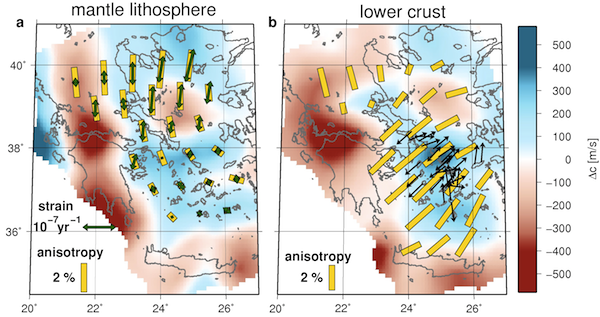2012 IRIS Workshop
Complex, Layered Deformation Within the Aegean Crust and Mantle Revealed by Seismic Anisotropy
Brigitte Endrun: University of Potsdam, Sergei Lebedev: Dublin Institute for Advanced Studies/IRIS Consortium, Thomas Meier: Christian Albrechts University of Kiel, Celine Tirel: Dublin Institute for
Anisotropic phase-velocity maps across the deforming Aegean region. Rayleigh waves at the periods sample primarily the lithospheric mantle (30 s, average reference velocity 3.77 km/s, a) and the lower crust (15 s, average reference velocity 3.24 km/s, b). Yellow bars indicate fast axes of anisotropy. Green arrows in (a) show the extensional component of the current strain field. Black arrows in (b) show Miocene stretching lineations, indicative of directions of palaeo-extension.

Full-resolution graphics file in original format: 0021.jpg
Continental lithosphere can undergo pervasive internal deformation, often distributed over broad zones near plate boundaries. Because of the paucity of observational constraints on three-dimensional movement at depth, patterns of flow within the lithosphere remain uncertain. End-member models for lithospheric flow invoke deformation localized on faults or deep shear zones or, alternatively, diffuse, viscous-fluid-like flow. Here we determine seismic Rayleigh-wave anisotropy in the crust and mantle of the Aegean region, an archetypal example of continental deformation. Our data reveal a complex, depth-dependent flow pattern within the extending lithosphere. Beneath the northern Aegean Sea, fast shear-wave propagation is in a North–South direction within the mantle lithosphere, parallel to the extensional component of the current strain rate field. In the south-central Aegean, where deformation is weak at present, anisotropic fabric in the lower crust runs parallel to the direction of palaeo-extension in the Miocene. The close match of orientations of regional-scale anisotropic fabric and the directions of extension during the last significant episodes of deformation implies that at least a large part of the extension in the Aegean has been taken up by distributed viscous flow in the lower crust and lithospheric mantle.
Acknoweldgements: This work was funded by the German Research Foundation within Collaborative Research Centre SFB 526 `Rheology of the Earth' and by Science Foundation Ireland (grant 08/RFP/GE01704). Earthquake data were provided by NOA, Greece (thanks to G. Stavrakakis), and GEOFON, GFZ Potsdam. GIPP, GFZ Potsdam, supplied seismic acquisition systems for CYCNET.
For further reading: Endrun, B., S. Lebedev, T. Meier, C. Tirel, and W. Friederich (2011), Complex layered deformation within the Aegean crust and mantle revealed by seismic anisotropy, Nat. Geosci., 4, 203–207. doi: 10.1038/ngeo1065
Keywords: anisotropy, continental_deformation
